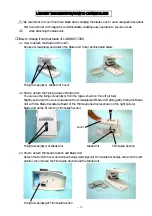
1.0
INTRODUCTION
Throughout this manual there are a number
of
HAZARD WARNINGS
that must be read
and adhered to in order to prevent possible
personal injury and/or damage to the equipment.
Three signal words "
DANGER
", "
WARNING
",
and "
CAUTION
" are used to indicate the
severity of the hazard, and are preceded by the
safety alert symbol
.
Denotes the most serious injury hazard,
and is used when serious injury or
death WILL result from misuse or
failure to follow specific instructions.
Used when serious injury or death
MAY result from misuse or failure to
follow specific instructions.
Used when injury or product/equipment
damage may result from misuse or failure
to follow specific instructions.
It is the responsibility and the duty of all
personnel involved in the installation, operation
and maintenance of the equipment on which this
device is used to fully understand the
,
and
procedures by which hazards are to be avoided.
1.1
Description
1.1.1
The Airflex
®
RTK Triple Passage Rotorseal was
designed as a rotary connection for simultane-
ous transfer of fluids and air through three sepa-
rate passages within the same rotating shaft.
1.1.2
A mounting flange simplifies installation to the
end of the shaft and serves as a manifold for
multiple passages.
1.1.3
Three of the pipe threaded ports provide access
to the internal rotating shaft. The center port on
the cover has been specified as the air inlet.
The 1" NPT port farthest from the mounting
flange is the water outlet and the 1" NPT port
closest to the mounting flange is the water inlet.
1.1.4
Consult the factory when attempting to use the
rotorseal with mediums other than water or air,
or at excessive speeds. See Operation section
for max. speed allowable.
1.1.5
The Airflex
®
RTK Triple Passage Rotorseal
was especially designed for use in sea water
service.
2.0
INSTALLATION
2.1
Mounting
NOTE: Rotorseal weight is 50.6 lb. [23Kg].
2.1.1
Ensure that the mounting surface is clean, flat,
and free of any nicks or burrs which may effect
proper sealing.
2.1.2
The rotorseal must be stud mounted. The use
of stainless steel fasteners is recommended.
The mounting flange is machined to accept
3/8" - 16NC3 studs. Use a threadlocking liquid
to retain the studs into the mounting plate. Use
locknuts or nuts and lockwashers to secure the
rotorseal on the studs Tighten the nuts evenly
to 28ft.-lb., using a crosswise sequence.
Ensure that exposed studs do not
interfere with hex head screws (5)
in the housing during operation.
2.2
Hose Connections
2.2.1
The rotorseal has three female pipe threaded
ports. The port in the center of the rotorseal
cover (3) is the air inlet. Two ports in the
housing (1) are inlet and outlet for water. The
port closest to the cover being water outlet.
See Table 2 for port sizes.
2.2.2
The connections to the rotorseal housing must
be through flexible hoses. Hoses should be
aligned to prevent excessive loading to the
rotorseal. All piping should be self supporting.
Rigid piping or hoses connected
to the rotorseal will damage the
rotorseal components.
RS 9210 (PDF Format)
3
® Copyright Eaton Corp., 2004. All rights reserved.
December, 2004


























